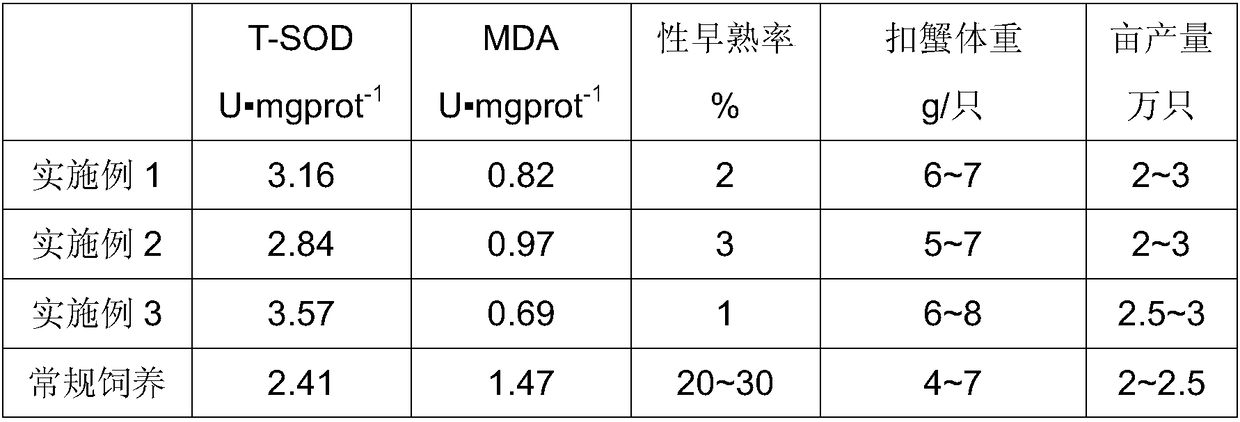Compound feed for crabs from larva stage to young crab stage, preparation method of compound feed
A technology for compound feed and crab deduction, which is applied in the field of river crab feed processing, can solve problems such as difficult to master and complicated operation, and achieve the effects of enhancing immunity, good palatability and reducing cost.
- Summary
- Abstract
- Description
- Claims
- Application Information
AI Technical Summary
Problems solved by technology
Method used
Image
Examples
Embodiment 1
[0026] A method for preparing compound feed from larvae to crab crab stage, comprising the following steps:
[0027] (1) 3 parts by weight of soybean meal, 1 part of rapeseed meal, 3 parts of bran, and 3 parts of fish meal are made into basic feed, soaked in water for 4 hours, absorb water until saturated, and remove;
[0028] (2) 1 part of lactic acid bacteria and 4 parts of EM bacteria are mixed into fermentation bacteria by weight, and the weight ratio of white sugar or brown sugar to fermentation bacteria is 3:1, and dissolved in water;
[0029] (3) Ferment the fermented liquid containing 3 parts of fermented bacteria and 100 parts of soaked basal feed for 10 days at a fermentation temperature of 25° C.;
[0030] (4) After fermentation, add 0.3 parts of vitamin C, 0.01 parts of trace elements, 0.3 parts of antimicrobial peptides, and 0.05 parts of astaxanthin, mix and dry; trace elements include 1 part of potassium iodide and zinc gluconate in parts by weight 8 parts, 3 p...
Embodiment 2
[0033] A method for preparing compound feed from larvae to crab crab stage, comprising the following steps:
[0034] (1) 4 parts by weight of soybean meal, 2 parts of rapeseed meal, 5 parts of bran, and 2 parts of fish meal are made into basic feed, soaked in water for 6 hours, absorb water to saturation, and remove;
[0035] (2) 2 parts by weight of lactic acid bacteria and 3 parts of EM bacteria are mixed into fermentation bacteria, mixed at a weight ratio of 4:1 between white sugar or brown sugar and fermentation bacteria, and dissolved in water;
[0036] (3) Mix and ferment the fermented liquid containing 4 parts of fermented bacteria and 100 parts of soaked basal feed at a fermentation temperature of 30° C. for 3 days;
[0037] (4) After fermentation, 0.4 parts of vitamin C, 0.02 parts of trace elements, 0.4 parts of antimicrobial peptides, and 0.1 parts of astaxanthin were added, mixed and dried; the trace elements included 2 parts of potassium iodide and 5 parts of zinc...
Embodiment 3
[0040] A method for preparing compound feed from larvae to crab crab stage, comprising the following steps:
[0041] (1) In parts by weight, 3 parts of soybean meal, 3 parts of rapeseed meal, 8 parts of bran, and 1 part of fish meal are made into basic feed, soaked in water for 8 hours, absorb water until saturated, and remove;
[0042] (2) 1 part of lactic acid bacteria and 3 parts of EM bacteria are mixed into fermentation bacteria by weight, and the weight ratio of white sugar or brown sugar to fermentation bacteria is 5:1, and dissolved in water;
[0043] (3) Ferment the fermented liquid containing 5 parts of fermented bacteria and 100 parts of soaked basal feed for 6 days at a fermentation temperature of 28° C.;
[0044] (4) After fermentation, add 0.5 part of vitamin C, 0.02 part of trace element, 0.5 part of antimicrobial peptide, and 0.08 part of astaxanthin, mix and dry; trace elements include 1.5 parts of potassium iodide and 7 parts of zinc gluconate 1 part, 5 part...
PUM
 Login to View More
Login to View More Abstract
Description
Claims
Application Information
 Login to View More
Login to View More - R&D
- Intellectual Property
- Life Sciences
- Materials
- Tech Scout
- Unparalleled Data Quality
- Higher Quality Content
- 60% Fewer Hallucinations
Browse by: Latest US Patents, China's latest patents, Technical Efficacy Thesaurus, Application Domain, Technology Topic, Popular Technical Reports.
© 2025 PatSnap. All rights reserved.Legal|Privacy policy|Modern Slavery Act Transparency Statement|Sitemap|About US| Contact US: help@patsnap.com

